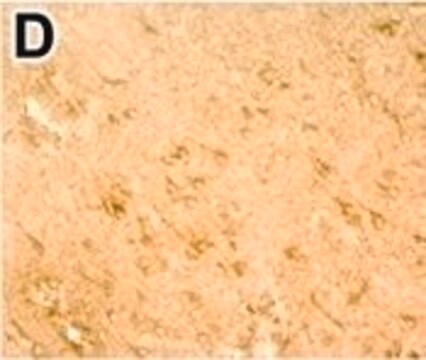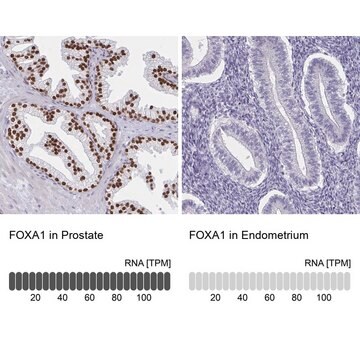D4692
Anti-DNMT1 antibody produced in rabbit
affinity isolated antibody, buffered aqueous solution
Synonym(s):
Anti-DNA methyltransferase
Sign Into View Organizational & Contract Pricing
All Photos(1)
About This Item
Recommended Products
biological source
rabbit
Quality Level
conjugate
unconjugated
antibody form
affinity isolated antibody
antibody product type
primary antibodies
clone
polyclonal
form
buffered aqueous solution
mol wt
antigen ~180 kDa
species reactivity
human, mouse
concentration
0.8-1.2 mg/mL
technique(s)
microarray: suitable
western blot: 0.5-1.0 μg/mL using nuclear extracts of 293T or HeLa cells
UniProt accession no.
shipped in
dry ice
storage temp.
−20°C
target post-translational modification
unmodified
Gene Information
human ... DNMT1(1786)
General description
In humans, the gene encodes a DNA (cytosine-5)-methyltransferase with 1616 amino acids. The N-terminal contains the regulatory domain, while the C-terminal region contains the catalytic domain. Two isoforms of DNMT1 have been isolated, DNMT1a and DNMT1b, the difference residing in 16 extra amino acids within the latter.
Immunogen
synthetic peptide corresponding to amino acids 72-78 of human DNMT1, conjugated to KLH via an N-terminal added cysteine residue. The sequence is conserved in mouse and is different from the rat sequence by one amino acid.
Application
Anti-DNMT1 antibody produced in rabbit is suitable for microarray and immunoblotting at a working concentration of 0.5-1.0μg/mL using nuclear extracts of 293T or HeLa cells. It was used at 1:1000 working dilution for immunoblot analysis in a study to analyze whether some miRNAs are aberrantly expressed and target DNMT1 in NiS (nickel sulfide)-transformed cells. It was used for immunoprecipitation of DNMT1 from nuclear lysates of colon cancer cells transfected with DNMT1 vectors in a study. It was used as a primary antibody at a working dilution of 1:1000 for western blot analysis of total protein extracted from left murine testis tissue exposed to low-dose-rate radiation in a study.
Applications in which this antibody has been used successfully, and the associated peer-reviewed papers, are given below.
Immunoprecipitation (1 paper)
Western Blotting (1 paper)
Immunoprecipitation (1 paper)
Western Blotting (1 paper)
Biochem/physiol Actions
DNMT1 protein is important for the maintenance of methylation, as well as for the novo methylation activities occurring in somatic cells of vertebrates. It establishes a repressive transcription complex at replication foci with histone deacetylase HDAAC4 and DMAP1.
Physical form
Solution in 0.01 M phosphate buffered saline, pH 7.4, containing 1% bovine serum albumin and 15 mM sodium azide.
Disclaimer
Unless otherwise stated in our catalog or other company documentation accompanying the product(s), our products are intended for research use only and are not to be used for any other purpose, which includes but is not limited to, unauthorized commercial uses, in vitro diagnostic uses, ex vivo or in vivo therapeutic uses or any type of consumption or application to humans or animals.
Not finding the right product?
Try our Product Selector Tool.
Storage Class Code
10 - Combustible liquids
WGK
WGK 2
Flash Point(F)
Not applicable
Flash Point(C)
Not applicable
Personal Protective Equipment
dust mask type N95 (US), Eyeshields, Gloves
Choose from one of the most recent versions:
Already Own This Product?
Find documentation for the products that you have recently purchased in the Document Library.
Eun Ji Gong et al.
Journal of radiation research, 55(1), 54-60 (2013-09-13)
This study examined the effects of continuous low-dose-rate radiation exposure (3.49 mGy/h) of gamma rays on mice testicles. C57BL/6 mice were divided into sham and radiation groups (n = 8 each), and were exposed to either sham irradiation or 2
Michael J Topper et al.
Cell, 171(6), 1284-1300 (2017-12-02)
Combining DNA-demethylating agents (DNA methyltransferase inhibitors [DNMTis]) with histone deacetylase inhibitors (HDACis) holds promise for enhancing cancer immune therapy. Herein, pharmacologic and isoform specificity of HDACis are investigated to guide their addition to a DNMTi, thus devising a new, low-dose
Haiqing Zhang et al.
Oncology reports, 40(3), 1803-1812 (2018-07-18)
Downregulation of microRNA‑152 (miR‑152) has been observed in various types of human malignancies, including Bladder cancer (BC). However, the role of miR‑152 in the development and progression of BC is still unclear. In our previous study, we identified a functional
Weidong Ji et al.
Carcinogenesis, 34(2), 446-453 (2012-11-06)
Nickel (Ni) compounds are well-recognized human carcinogens, yet the molecular mechanisms by which they cause human cancer are still not well understood. MicroRNAs (miRNAs), which are small non-coding RNAs, are involved in diverse biological functions and carcinogenesis. In previous study
I Rhee et al.
Nature, 404(6781), 1003-1007 (2000-05-09)
Hypermethylation is associated with the silencing of tumour susceptibility genes in several forms of cancer; however, the mechanisms responsible for this aberrant methylation are poorly understood. The prototypic DNA methyltransferase, DNMT1, has been widely assumed to be responsible for most
Our team of scientists has experience in all areas of research including Life Science, Material Science, Chemical Synthesis, Chromatography, Analytical and many others.
Contact Technical Service






